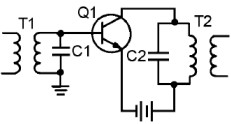Definitions of Technical Terms
"A"
"B"
"C",
"D",
"E",
"F",
"G",
"H",
"I",
"J",
"K",
"L",
"M",
"N",
"O",
"P",
"Q",
"R",
"S",
"T",
"U",
"V",
"W",
"X",
"Y",
"Z"
"T" to "Ter", "Tes",
"Thermb" to "Top",
"Tor" to "Transf",
"Trans" to "Tre",
"Triac" to "Tub",
"Tun" to "Tz"
Tuned. Adjusted to operate within a specific range or frequency.
Tuned Amplifier. An amplifier designed to operate in a narrow band of frequencies.
Tuned Circuit. A circuit consisting of inductance and capacitance that can be adjusted for
resonance at a desired frequency. A circuit that is used as a filter which passes or rejects specific
frequencies. An LC circuit used as a frequency-determining device. The circuit to the right uses a tuned circuit consisting of C2 and T2.
Tuned Line. A resonant line. This line uses tuning devices to eliminate the
reactance and transfer maximum power from the source to the line.
Tuned Tank Circuit. An LC circuit or Tank circuit.
Tuned Transformer. Text in review.
Tuner. A unit that contains an amplifier, mixer and local oscillator. A component that changes the frequency of a tuned circuit. A circuit used to select a particular frequency band.
Tuning Capacitor. A variable capacitor used to set the frequency of an oscillator or resonant frequency of a tuned circuit.
Tuning Fork. A style of contact used with connectors that resemble a tuning fork. Refer to Fork Contacts.
Tuning Stub. Text in review.
Tunnel Diode. A heavily doped semiconductor device that has high gain and fast switching
capabilities. A pn diode which has a negative resistance characteristic. Also See Negative-Resistance Element. Refer to Definition of Diode Terms.
Tunneling. The piercing of a potential barrier in a semiconductor by a particle (current carrier) that
does not have sufficient energy to go over the barrier. A technique of embedding or encapsulating a network protocol within packets carried by the second network, so that one network can communicate with another network via a third network. Network 'A' communicates with network 'B' through network 'C' by encapsulating it's data within networks 'C' data packages.
Turn. One complete loop of a conductor about a core.
Turns Ratio. The ratio of the number of turns in the primary winding to the number of turns in the
secondary winding of a transformer. Refer to Transformer Terms.
TVS. See Transient Voltage Suppressor.
Tweeter. A speaker designed to operate in the higher frequency ranges, normally reproducing sound between 5K and 20KHz.
Twinax. Twin-Axial. Dual Axial Leads. Normally meaning leads that follow the axis of the component, protruding out both ends. In this case, two leads that follow the axis. For more detail refer to the Twinax Connector Definition [which is located in the dictionary of Radar Terms].
Twinaxial Cable. A coaxial cable used to connect to a Twinax connector, although the cable needs to have two signal conductors to attach to a Twinax connector.
Twin Cable. [Twin-Lead] A cable composed of two parallel conductors separated from each other by a ribbon-like insulator or encased by a foam insulator.
Twin-Lead. The more common name for two parallel lines separated by an insulator, sometimes also called a two-wire ribbon cable. The size of the conductors and the spacing of the leads determine the impedance of the cable. A Twin-Lead cable is also called a balanced transmission line.
Twisted Pair. A line consisting of two insulated wires twisted together to form a flexible line without the use of spacers. A cable may hold one or more Twisted Pair sets. Read more on Detailed Twisted Pair definition. |
 Twisted Pair Cable |
Twist-On Connector. A type of connector that requires a twisting motion to mate to connectors, as in a BNC connector.
Twist-On Wire Connector. See wire nut. An electrical connector that accepts two wires and secures them together, sizes change as different gauge wires are used.
Two-Wire Open Line. A parallel line consisting of two wires that are generally spaced from 2 to 6 inches apart by insulating spacers.
Two-Wire Ribbon. [Twin Lead] A parallel two-wire line in which uniform spacing is assured by two wires embedded in a low-loss dielectric. Design note; Replace any twin-lead cable with a coaxial cable; a coaxial cable offers the best protection from all types of outside interference.











